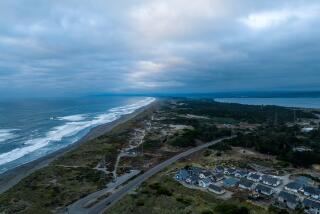L.A.’s carbon footprint called lighter than most
- Share via
OK, here’s a quiz: Does sprawling, freeway-scarred, SUV-worshiping, coal-dependent Los Angeles have a heavier or lighter carbon footprint compared with the 99 other big cities in America?
If you guessed heavier, think again.
According to the Brookings Institution, a prestigious Washington think tank, the Los Angeles metropolitan area emits less planet-warming carbon per capita than any big city except Honolulu, at least by some criteria.
In a report to be released today on energy use in residential buildings and highway transportation, Brookings ranks Los Angeles as greener than New York, with its network of subways; more virtuous than Portland, Ore., with its smartgrowth greenbelt, and, yes, even better than San Francisco, its eco-vain rival.
“We are not at all surprised,” said Nancy Sutley, L.A.’s deputy mayor for energy and environment, citing the city’s “moderate climate, with fewer heating and air-conditioning days, and its relatively newer, less drafty housing stock” than in many parts of the U.S.
Moreover, she added, “sprawl is a lot worse in other parts of the U.S.”
But before the boasting starts, some words of caution: The calculations did not account for the fact that half the city’s electricity comes from coal-fired power plants. Instead, Brookings used a state-wide average that included the hydroelectric and nuclear plants in Northern California.
Omitted from the data are emissions from industries and commercial buildings, and from local roads apart from federal highways.
The researchers also chose metropolitan statistical areas, as defined by the U.S. Census Bureau. Those areas may allow for a uniform geographical comparison, but in the case of the Los Angeles-Long Beach-Santa Ana area, that omitted commutes from as far as Ventura, San Bernardino or Riverside counties.
“The data is fuzzy,” said Andrea Sarzynski, a senior research analyst at Brookings. “We do the best we can.”
The 83-page report gives much of the credit to California’s overall carbon-saving plans, including a stringent state building code and strict utility pricing rules for energy conservation. Three other Golden State cities -- San Jose, San Francisco and San Diego -- rank among Brookings’ top 10 in small per-capita footprints.
By contrast, the report highlights the heavy carbon footprints of Southern, Midwestern and Northeastern regions of the country.
“The Mississippi River roughly divides the country into high and low emitters,” it says. “In 2005, all but one of the 10 largest per capita emitters were located east of the Mississippi.”
The north-south divide is also evident, with seven of the highest per capita emitters south of the Mason-Dixon line, including two each from Tennessee and Kentucky -- both coal-reliant states with little mass transit.
The report’s timing is no accident.
As the Bush administration fended off pressure in recent years to sign the 1997 Kyoto Protocol, an international treaty limiting greenhouse gases, more than 800 U.S mayors signed a “Climate Protection Agreement” to cut their cities’ emissions to 7% below 1990 levels, the Kyoto target.
But “metros can’t go it alone in solving as vast a problem as climate change,” said Mark Muro, director of Brookings’ “Blueprint for American Prosperity” initiative.
Emissions from residential, commercial and transportation sectors each increased by more than 25% over the last 25 years, the report notes, while industrial emissions declined as manufacturing dwindled.
Next week, the U.S. Senate is expected to take up legislation to limit carbon emissions nationwide. Its provisions, which include a cap-and-trade system for greenhouse gases, are highly controversial, and Brookings wants aggressive measures to encourage climate-friendly cities.
The report calls on the federal government to put a price on carbon, making coal-fired electricity more expensive, and to establish a renewable electricity standard, requiring that a certain percentage of the nation’s power come from alternative sources such as wind and solar plants.
Twenty-six states and the District of Columbia already have renewable portfolio standards. The California Legislature is considering boosting the state’s percentage from 20% to 33% by 2020.
The report also calls on the federal government to stop favoring highway building over mass transit. And it suggests legislation that would reward utilities for conserving, as California does. Another recommendation: Require all home-sellers to disclose the energy costs of their homes for several years.
Although some had quibbles with their rankings, city officials praised Brookings for highlighting the need for the federal government to focus on cities. Two-thirds of Americans live in large metropolitan areas and three-quarters of the nation’s economic activity takes place there, according to the report.
“Local governments set land-use planning and develop transportation systems, and local governments enforce -- and often establish -- building codes,” said Michael Armstrong, deputy director of Portland’s Office of Sustainable Development. “All cities have huge opportunities to reduce emissions, regardless of where they are today.”
--
--
(BEGIN TEXT OF INFOBOX)
Best and worst
Metropolitan areas with the lowest carbon footprints:
* 1. Honolulu, Hawaii
* 2. Los Angeles-Long Beach-Santa Ana, Calif.
* 3. Portland-Vancouver- Beaverton, Ore.-Wash.
* 4. New York-Northern New Jersey-Long Island, N.Y.-N.J.
* 5. Boise City-Nampa, Idaho
* 6. Seattle-Tacoma-Bellevue, Wash.
* 7. San Jose-Sunnyvale-Santa Clara, Calif.
* 8. San Francisco-Oakland- Fremont, Calif.
* 9. El Paso, Texas
* 10. San Diego-Carlsbad-San Marcos, Calif.
Highest carbon footprints:
* 1. Lexington-Fayette, Ky.
* 2. Indianapolis, Ind.
* 3. Cincinnati-Middletown, Ohio-Ky.-Ind.
* 4. Toledo, Ohio
* 5. Louisville, Ky.-Ind.
* 6. Nashville-Davidson- Murfreesboro, Tenn.
* 7. St. Louis, Mo.-Ill.
* 8. Oklahoma City, Okla.
* 9. Harrisburg-Carlisle, Pa.
* 10. Knoxville, Tenn.
Source: Brookings Institution







